Search Results
Filter by Topic
Tips and Tricks for Uploading Documents to Your SimpleCitizen Account
Here are a few tips that may help you upload documents to your SimpleCitizen account.
Getting Started
With every form submitted to USCIS, supporting documentation must be provided. The following article outlines some tips and tricks to ensure that the supporting documents accompanying your application will be clear and easy to read and will give you ideas for uploading them as efficiently as possible.
Why do I need to upload supporting documents?
USCIS requests supporting documentation for most of its forms. For some forms, this documentation can span 5-10 pages of important identifying documents [such as copies of an applicant’s passport, visa, I-94, and EAD (work authorization), if applicable]. For other forms, the documentation required can be as many as 100-200 pages or more! Whether you are uploading a few pieces of supporting documents or many pages, we want to help you upload documents as quickly as possible and in a way that will allow USCIS to see and read clearly everything you are providing.
What kinds of file types are accepted by the SimpleCitizen system?
Uploading files saved as a PDF is often best since it preserves the documents' quality, allowing for them to be clear and easy to read. However, if a PDF option is unavailable, the SimpleCitizen system accepts the following file types: JPG, JPEG, PNG, PDF, and TIF.
Many free resources can help you to convert an existing file into a PDF, such as Adobe’s PDF Converter or PDF Converter - Convert files to and from PDFs Free Online. Some email servers also provide resources for creating files and exporting them as PDFs. Please research to ensure that you use a resource that you feel is safe and reliable.
Tips and Tricks for uploading government-issued documents:
Many USCIS forms require you to add multiple government-issued documents to an application as supporting documentation. The following list gives examples of some of these documents:
- A birth certificate
- Marriage certificate
- Marriage Termination documents (if applicable)
- Passport
- Visa
- I-94 from most recent arrival into the US (if applicable)
- Driver’s license/ Green Card/ Certificate of Naturalization or Citizenship (if applicable)
- Receipt notices from previously filed petitions, such as Form 797C
USCIS must receive clear and easy-to-read copies of these identifying documents. To provide a quality scan of these documents, please aim to:
- Ensure that all edges of the document are visible
- Include a scanned copy that is saved as a PDF when possible
- If taking a picture of the document, please ensure no other visible distractions are in the background. You can do this by photographing the document against a white background.
- Reduce the appearance of shadows and obstructions
If the scan you are uploading does not meet these requirements, consider replacing them with scans of better quality. In some cases, requesting new copies of government-issued documents may be beneficial to provide scans of the best quality possible.
Tips and Tricks for organizing and uploading large amounts of evidence:
In many cases, USCIS asks for robust documentation that can span 100-200+ pages. Such is often the case for Marriage-Based petitions that require relationship evidence or applications that require proof of financial support.
Here are a few tips that may help you upload large amounts of evidence at once:
- Merge Files: Applicants are welcome to upload individual photos and documents to their application if they like. However, doing this may exhaust the limit of individual uploads allowed by the SimpleCitizen system. It may be beneficial to consolidate multiple pages/documents into a single file type, such as a PDF, to prevent this from happening. A “Merge” feature may also be helpful if wishing to combine multiple files into one document. Please research to ensure that you use a resource that you feel is safe and reliable.
- Add Multiple files to a Document and Save as a PDF: Once you upload documents to your SimpleCitizen account, there is limited ability to edit and rearrange them. Suppose you prefer more control over the order in which your relationship evidence/financial documents appear in the final application. In that case, you can paste your photos and documents into a Word Document/Google Doc or Powerpoint/Google Slides. Then, save that file as a PDF and upload it as one.
Pro tip: Powerpoints/Google Slides can be particularly helpful for rearranging pages of photos since Powerpoint/Google Slides pages are much more straightforward to rearrange than Word/Google Doc pages. - Upload Files as PDFs: Please upload any word-heavy documents (such as letters of support, screenshots of emails, bank statements, etc.) as PDFs, not as JPEGs. Uploading them as JPEGs will decrease the image quality and make it very difficult to read the information. We recommend using a resource that can help you convert your file into a PDF when possible, such as Adobe’s PDF Converter or PDF Converter - Convert files to and from PDFs Free Online. Please research to ensure that you use a resource that you feel is safe and reliable.
- Label Files: Another strategy that can be helpful is clearly labeling files before uploading them to the SimpleCitizen.Doing so makes it much easier to make adjustments later in the process, which can come in handy.
The file I want to upload will not upload to my SimpleCitizen account. What can I do?
Your SimpleCitizen account has a limit on how many individual files can you can add to a single upload category. If you add too many separate files, the system may not allow you to add any more. In these cases, it may be beneficial to consolidate multiple pages/documents into a single file type, such as a PDF. A “Merge” feature may be helpful in this case. Please research to ensure that you use a resource that you feel is safe and reliable.
Additionally, your SimpleCitizen account limits the size of a file to 12MB. If your file is larger than 12 MB, it will not upload to the SimpleCitizen website as is. However, some easy solutions can help you bypass this limit!
- A quick solution to uploading a file over 12 MB is to reduce the file size. To do so, we recommend “compressing” a file. You may use a resource of your own or one like Adobe’s PDF Compressor or Compress PDF: Reduce File Size Online for Free to compress or reduce the “size” of a file without having to remove any of the contents of the file. Please research to ensure that you use a resource that you feel is safe and reliable.
- If you cannot compress a file, it may be necessary to separate it into 2 pieces (or more, if necessary) so that its size is under 12 MB, and you can upload it to your SimpleCitizen account. You may use a resource of your own or one like Adobe’s Split a PDF or Split PDF - Extract pages from your PDF to split a PDF file without removing any of the contents. Please research to ensure that you use a resource that you feel is safe and reliable.
Following these tips and tricks will help you ensure that the supporting documents attached to your application are clear and easy to read when USCIS processes them. If you have any additional questions or experience issues while uploading a document to your SimpleCitizen account, don’t hesitate to Contact Support or reach out to us in our live chat (open Monday - Friday, 9 AM-5 PM MST).
Calculating When to File for the Removal of Conditions
Understanding the filing window for your 2-year, conditional green card.
Green Card Renewals, Replacements and Removal of Conditions
USCIS requires people to file to remove the conditions on their 2-year, conditional green card. If filing jointly with your spouse or parent’s spouse this must only be filed within the 90 days before it cards expiry date. Filing the removal of conditions application before the 90-day window results in the rejection of the application and filing after the 90-day window could result in the denial of the application. This 90 day rule does not apply for certain situations such as those shown on the following chart from USCIS:
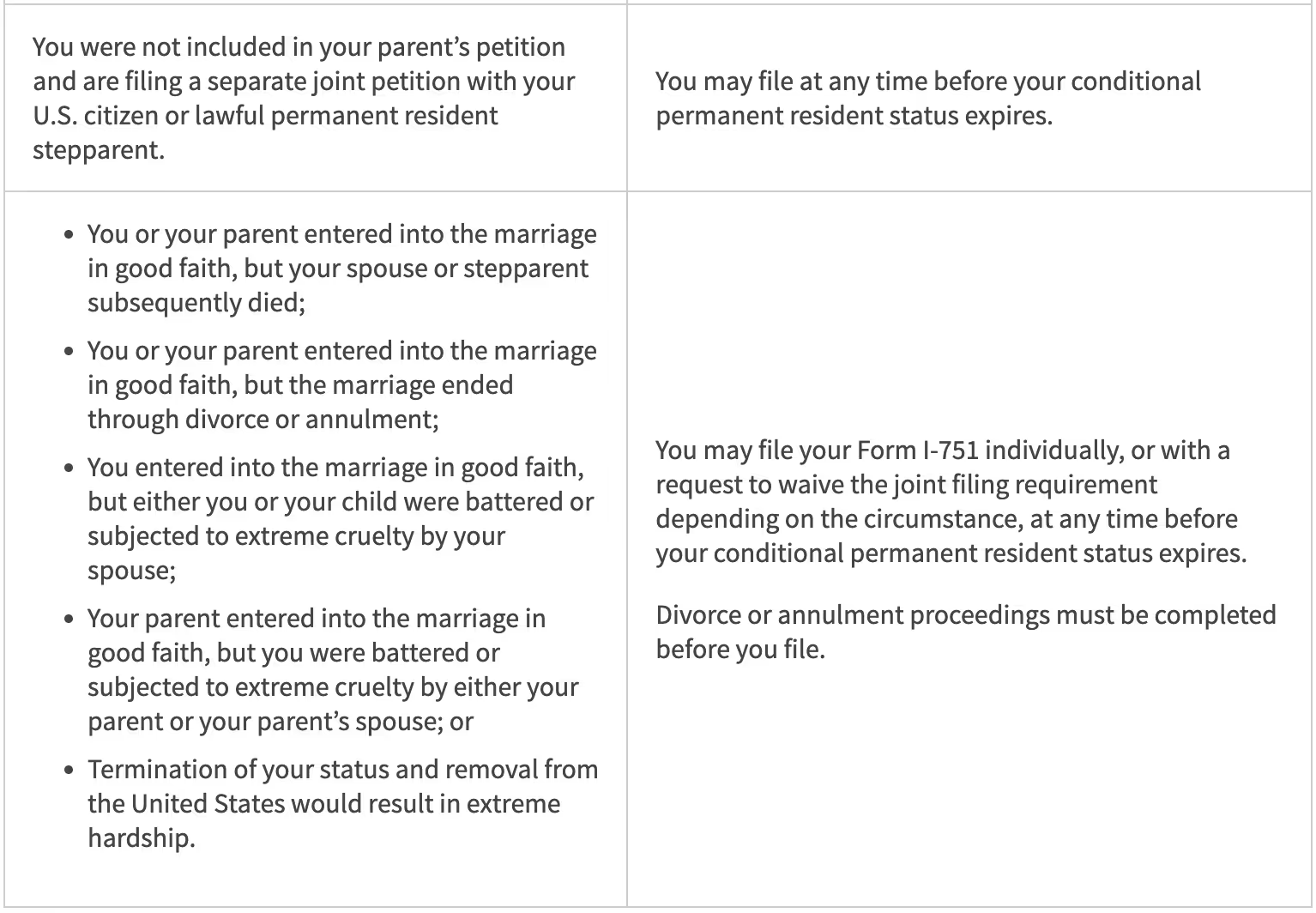
Please note that USCIS calculates the submission date based on the day the application arrives at their office. Applicants should take care that they do not accidentally have their application delivered even one day early. Applicants have been rejected because the mailing service they used got their application to USCIS one day before their 90-day window began.
When necessary, an applicant can file after the 90 day period by providing a good explanation along with the application detailing the circumstances that caused them to file late. However, please note that this does not guarantee that USCIS will accept the late filing, though it can help increase the odds.
You can calculate your approved filing window using the USCIS filing date calculator here. In order to use this calculator, you will need to know the expiry date of your Conditional Permanent Residence, which should be listed on your 2-year green card.
Additionally, please feel free to use the following examples to help you better understand how to determine the approved filing window for your Removal of Conditions application.
Example: If Sarah’s 2-year conditional green card expires on July 4th, 2023 (07/04/2023) the soonest she would be able to file her I-751 application with USCIS sometime between April 5th 2023 (04/05/2023) and July 4th, 2023.
Immigration Term Dictionary
Here are some of the most commonly used USCIS terms and their definitions.
General Immigration Information
Introduction:
Immigration terms can be hard to wrap your head around – especially when you are just starting your immigration journey. To assist you with this, we have compiled some of the most commonly used USCIS terms and their definitions. For a more extensive list of Immigration terms and their definitions, please refer to the USCIS Glossary.
Terms:
A
A-Number/Alien Registration Number/Alien Number (A-Number or A#)
An A-number is an unique seven-, eight- or nine-digit number assigned to a noncitizen by the Department of Homeland Security, used for identification purposes. Also see USCIS Number.
Most people aren’t granted an A-number until they file for a green card, so if you don’t have one yet, don’t worry. However, one exception to this is that students on F-1 visas who are granted work authorization are likely to be assigned an A-number on their EAD card, when issued.
Once you apply for a green card, your A#-number should be listed on all of the documents sent to you by USCIS, including the I-797 notices.
Pro Tip: USCIS will sometimes assign out multiple A#s to an applicant during the immigration process. Be sure to record all A-numbers in a safe place.
Adjustment of Status
Adjustment of Status is the process that you can use to apply for lawful permanent resident status (also known as applying for a Green Card) when you are present in the United States. This means that you may get a Green Card without having to return to your home country to complete visa processing. (Please note that this is different from a Change of Status).
Typically, one would need to submit Form I-485 in order to file to adjust their status.
For more information on Adjustment of Status, please see the following resources:
- What is Adjustment of Status
- Form I-485 Step-by-Step Instructions
- Maintaining H-1B Visa vs Using Adjustment of Status Work and Travel Permit
- What Evidence Must you Provide with Form I-485?
Affidavit
An affidavit is a document in which a person gives facts, and swears that the facts are true and accurate.
For an example of a type of affidavit, see the following article.
Arrival-Departure Record (Form I-94/I-94A)
The Arrival and Departure Record is the I-94, in either paper or electronic format, issued by a Customs and Border Protection (CBP) officer to foreign visitors entering the United States. As of April 30, 2013, most Arrival and/or Departure records are created electronically upon arrival.
For more information, see the following USCIS webpage.
To look up your more recent Form I-94 and/or Travel Record, see the following webpage.
B
Beneficiary
A Beneficiary is an individual who is sponsored by a relative or a business, or has self-petitioned for an immigration benefit. They can also be referred to as the applicant or the intending immigrant.
For example, if a US citizen spouse is hoping to sponsor their spouse for a green card, the spouse needing a green card would be the beneficiary.
C
CBP
An abbreviation for U.S. Customs and Border Protection, an agency of the Department of Homeland Security that is responsible for securing the homeland by preventing the illegal entry of people and goods while facilitating legitimate travel and trade.
Certificate of Citizenship
This is an identity document proving U.S. citizenship. Certificates of Citizenship are issued to derivative citizens and those who acquired U.S. citizenship..
Certificate of Naturalization
A certificate given at the oath ceremony. It serves as evidence of your citizenship.
Civil Surgeon
A Civil Surgeon is a medically trained and licensed physician having no less than 4 years’ experience who is designated by USCIS to perform immigration medical exams in a state where the physician is licensed and practicing medicine.
Civil surgeons practice within the United States. If you are completing your medical exam outside of the United State, you would go through what is called a Panel Physician. Information about Panel Physicians and which ones can be used is provided by the Consulate/Embassy processing the application.
IMPORTANT: Medical examinations will not be recognized if they are given by a doctor in the U.S. who is not a civil surgeon. Please make sure that your appointment is with a civil surgeon, or your results and documents will be invalid.
For more information on the medical exam within the United States, see the following article.
Find a Civil Surgeon near you here.
Conditional resident
Any alien granted permanent resident status on a conditional basis (for example, a spouse of a U.S. citizen or an immigrant investor) who must petition to remove the conditions of their status before the second anniversary of the approval date of their conditional status.
See the following articles to learn more about Removing Conditions from a Conditional Permanent Resident card.
- 5 Tips for Removing Conditions After a Divorce
- What happens after submitting your I-751 – Petition to Remove Conditions?
- Form I-751 & How to Prove Your Marriage is Legitimate
D
Duration of Status (D/S)
Duration of Status (D/S) is a notation on certain nonimmigrant Forms I-94 indicating that a person, such as an F-1 nonimmigrant student, is authorized to remain in the United States as long as they maintain a valid status. In other words, for the duration of their status.
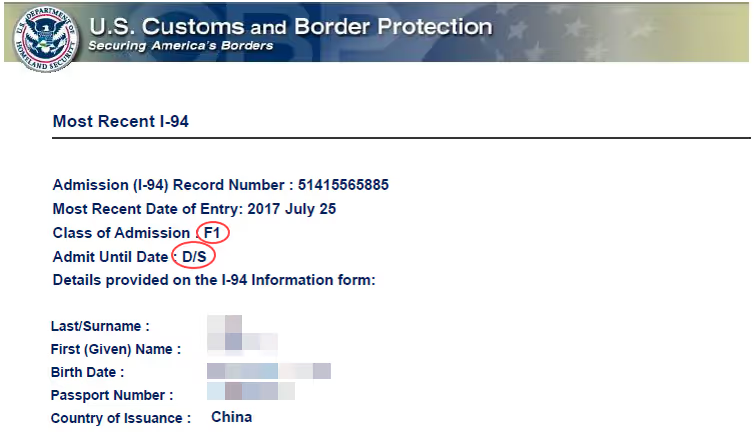

E
Employment Authorization Document (Form I-766/EAD)
A general term used to describe a card USCIS issues on Form I-766, Employment Authorization Card, to aliens who are authorized to work in the United States. The card contains a photograph of the individual and sometimes his or her fingerprint. An alien who has an EAD usually has open-market employment authorization, but there are exceptions.
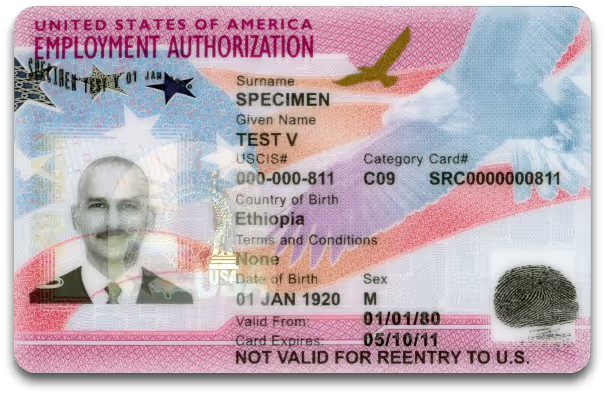
To learn more about EAD’s, see the following articles:
- Form I-765 EAD Step by Step Guide
- What is an EAD or OPT?
- Submitting an Expedite Request for the Employment Authorization Document (EAD)
F
F-1 Nonimmigrant Student
A person who has been admitted to the United States as a full-time academic student at an accredited college, university, seminary, conservatory, academic high school, elementary school or other academic institution, or in a language training program. The student must be enrolled in a program or course of study that culminates in a degree, diploma or certificate, and the school must be authorized by the U.S. government to accept international students.
To learn more about F1 Visas, see the following Articles:
- F1 Student Visa
- How Do I Apply For an F1 Visa?
- Can I change my F1 status to another non-immigrant status?
- What documents do I need in order to apply for an F1 visa?
- How long can I stay in the U.S. on an F1 visa?
- Can I work while in the United States on an F1 Visa?
- What are my employment options as an F1 Visa holder?
- Can I travel abroad while I am in the United States on F1 status?
Field office
Field offices are offices within a USCIS district that provide services and enforcement functions for a particular portion of the district.
Please note that applicants are assigned a specific field office depending on their physical address. USCIS does not allow for people to request specific field offices.
Use this link to find the field office nearest to you.
G
Green Card
A green card is also known as a Permanent Resident Card, Form I-551, or alien registration card. USCIS issues Green Cards to aliens as evidence of their lawful permanent resident status in the United States. For Form I-9, it is acceptable as proof of identity and employment authorization. Although some Green Cards do not have an expiration date, most are valid for 10 years. Cards issued to individuals with conditional permanent resident status are valid for two years.
To find out if you are eligible to apply for a Green Card, you can use our Eligibility Quiz Here.
I
Immediate Relative
USCIS offers specific protections or exemptions for the immediate relatives of US Citizens. Immediate relatives refer to the nature of the relationship between the petitioner and the beneficiary and includes the following relationship types:
- The spouses of U.S. citizens,
- The children (unmarried and under 21 years of age) of U.S. citizens,
- The parents of U.S. citizens at least 21 years old, and
- Widows or widowers of U.S. citizens if the U.S. citizen filed a petition before his or her death or if the widow(er) files a petition within 2 years of the citizen’s death.
Any other relationship type would not be considered to be an immediate relation. Examples of these other relationships include, but are not limited to, the following examples:
- The aunts or uncles of U.S. Citizens
- The Cousins of U.S. Citizens
- The siblings of U.S. Citizens
L
Last name
Family name or surname.
Lawful Permanent Resident (LPR)
Any person not a citizen of the United States who is living in the U.S. under legally recognized and lawfully recorded permanent residence as an immigrant. Also known as “permanent resident alien,” “resident alien permit holder,” and “Green Card holder.”
M
Maiden name
A woman’s last name or family name at birth, before she married.
Mailing Address
The address where you would like to receive written correspondence from USCIS.
N
Naturalization
Naturalization is the manner in which a person not born in the United States voluntarily becomes a U.S. citizen.
To learn more about Naturalization and the N-400, see the following articles:
- How to Become a United States Citizen
- Applying for U.S. Citizenship: 10 Most Common Questions
- What Happens After Submitting Your Form N-400?
- 4 Common Reasons Citizenship Applications are Denied
- How to Apply for Citizenship while Serving in the United States Military
- What is “Good Moral Character?”
To find out if you are eligible to apply for Citizenship, use our Eligibility Quiz here.
P
Permanent resident
See Lawful Permanent Resident.
Permanent Resident Card (Form I-551)
Also known as a Green Card or alien registration card, this card is issued by USCIS to aliens as evidence of their lawful permanent resident status in the United States. For Form I-9, it is acceptable as proof of identity and employment authorization. Although some Permanent Resident Cards contain no expiration date, most are valid for 10 years. Cards held by individuals with conditional permanent resident status are valid for two years.
Petitioner
A petitioner is a person who files an immigration petition or application on behalf of the beneficiary/intending immigrant.
For example, if a US citizen spouse is trying to get their spouse a green card, the US citizen spouse would be the petitioner and their spouse would be the beneficiary.
Processing Times
Processing times are an estimate of how long it will take to process your case from start to finish. Each case is different, so some cases may take longer than others to process. These processing times tend to be form- and location-specific. You can find our average processing times on the USCIS website. If you use your receipt number to check your case status, please remember that USCIS will only research your case if it is beyond their current processing times.
To look up the current processing times for your assigned field office, go to the following webpage.
R
Re-entry Permit
Permanent or conditional residents should apply for a re-entry permit if they will be outside the United States for one year or more. A valid re-entry permit allows you to apply for admission to the U.S. without having to get a returning resident visa from a U.S. Embassy or Consulate.
Receipt Number
The receipt number is a unique 13-character identifier that USCIS provides for each application or petition it receives. The agency uses it to identify and track its cases.
The receipt number consists of three letters-for example, EAC, WAC, LIN, SRC, NBC, MSC or IOE-and 10 numbers. You can find it on I-797 notices of action (also known as receipt notices) USCIS has sent you via the mail or digitally to your USCIS account.
Request for Evidence (RFE)
USCIS may send you a request for additional evidence if:
- You did not submit all the required evidence;
- The evidence you submitted is no longer valid; or
- The officer needs more information to determine your eligibility.
This request is placed by sending the applicant or petitioner a letter detailing what is being requested and when it needs to be submitted by.
S
Service centers
Service centers only adjudicate applications that individuals have mailed, filed electronically, or filed with a USCIS Lockbox. Service centers do not provide in-person services, conduct interviews, or receive walk-in applications or questions. USCIS has five service centers: California, Nebraska, Potomac, Texas, and Vermont.
Sponsor
In the immigration field, the term “sponsor” often means to bring to the United States or “petition for.”
Another meaning of the term “sponsor” is a person who completes Form I-864, Affidavit of Support Under Section 213A of the Act. However, this type of sponsorship is not the first step in any immigration process.
U
U.S. Citizenship and Immigration Services (USCIS)
USCIS is a federal agency in the Department of Homeland Security that oversees lawful immigration to the United States. Its functions include:
- Granting employment authorization to eligible aliens;
- Issuing documentation of alien employment authorization;
- Maintaining Forms I-9; and
- Administering the E-Verify employment eligibility verification program.
USCIS Number
A USCIS Number is a unique, 9-digit number assigned to a noncitizen by the Department of Homeland Security that is listed on the front of Permanent Resident Cards (Form I-551) issued after May 10, 2010. See also Alien Number.
USCIS Online Account Number
Your USCIS Online Account Number (OAN) is a unique identification number issued by the USCIS online filing system account. You should have one account number for all cases submitted.
SimpleCitizen Processing Timelines
Summary of the steps involved in SimpleCitizen’s online immigration services and their timelines.
Getting Started
Welcome to our guide on SimpleCitizen timelines! In this article, we’ll discuss the steps involved in using SimpleCitizen’s online immigration services and provide an overview of the timeline for each step in the process after signing up.
Step 1: Fill out the questionnaire
To get started with SimpleCitizen, you begin by filling out a questionnaire and uploading your documents to your account. Filling out the questionnaire takes about 2-4 hours to complete. The time it takes to complete this step will depend on how quickly you can gather and upload all the necessary information and documents. Filling out the questionnaire and gathering all of the required documents together to upload them can take a few days to a few weeks.
- Call Out Box: Pro Tip: Collecting all of your documents before sitting down to start filling out the questionnaire can help make this step go faster. Please check out the following article to see some of the general documents that are usually required.
If you need to have any of your documents translated, please allow 1-2 business days after uploading them. We offer translation of USCIS-required documents, such as Birth Certificates, Marriage Certificates, Final Divorce Decree, and Military Records. You can read more about the translation of documents here. Any other documents in foreign languages not explicitly asked for by USCIS are not translated as part of the SimpleCitizen purchase, but you must provide a translation if you would like to include those documents.
Step 2: Attorney Review
Once you have submitted your application for review, our independent partner immigration attorneys will review your application. The attorney review process will take approximately 5-10 business days. Once the review has been completed, you'll be assigned a SimpleCitizen case support team who will contact you with the attorney's feedback.
Step 3: Implement updates
Once your SimpleCitizen case support team sends you the attorney’s feedback, you should carefully implement the suggestions. The SimpleCitizen case support team will work with you to ensure that any feedback from the attorney is implemented correctly. This process can take a few days to a few weeks, depending on the extent of the feedback and how quickly you can make the necessary updates.
Step 4: Review the Final PDF
Once your case support team has confirmed that you have implemented all of the attorney’s recommendations correctly, we will send you a PDF draft of your application for you to review. During this review process, you will need to check that all of your personal information and translations are accurate. If you notice any errors or need to make any updates, you should check your questionnaire to ensure that the information was entered correctly. If it was entered correctly in the questionnaire but is showing up wrong on the application, please inform your case support team. It is normal for there to be a few rounds of revisions before the application is ready to be printed. This step in the process usually takes 1-2 business days, depending on how quickly you are able to review the application and provide feedback.
Step 5: Print and Ship the Application
After you've made all necessary updates and approved a final pdf of your application, it will take 1-2 business days to print and 3-5 business days for the shipping provider to ship the application to your home. You'll need to sign the forms, attach the required application fee payments and passport-sized photos, and mail the application to the USCIS.
**Please note that SimpleCitizen is not responsible for any shipment delays or issues caused by the shipping provider
Our Process
We hope this guide helps give you a better understanding of the timeline for using SimpleCitizen’s immigration services. It's important to note that this timeline is specific to SimpleCitizen and may not apply to other immigration assistance services. If you have an urgent timeline and are unsure if we can help you, please reach out to our live chat. We’re happy to work with you in whatever way we can.
Additionally, the overall timeline for the immigration process can vary significantly depending on the specific circumstances of each case and the type of immigration application being submitted. You can look up USCIS processing times here. The U.S. immigration process can be complex, so it's always a good idea to carefully review the requirements and timelines for your specific situation and to be prepared for potential delays. Let us know if you have any questions, we're here to help!
Tax Documents for the Green Card Application
Understanding which tax documents are needed for Form I-864.
Green Card Application
All people applying for a family-based green card are required to provide the financial information for a Sponsor to show that they will have access to financial support in the US once they receive their green card. In most family-based cases, the petitioning family member is the primary sponsor for the application. This sponsorship is done by filing Form I-864, Affidavit of Support.
In order to be eligible to sponsor, the petitioner (or Joint Sponsor, if applicable) must show that they met the income requirements for their household size for both the current year and the most recent tax year. To verify whether they met the requirements for the most recent tax year, USCIS asks for the sponsor’s tax documents. These tax documents can be difficult to navigate, however, so we have put this guide together to help you understand exactly which documents are required, and how you can locate these documents.
What tax documents does USCIS require?
The documents needed will vary depending on whether the sponsor filed their taxes Married Filing Jointly or not. The list below shows the options for tax documents based on their filing status:
Married Filing Jointly
If they filed their taxes Married Filing Jointly, they have two options:
- Option 1: Upload the IRS Tax Return Transcript (request it for free here) and any associated W-2s and/or 1099s for each year.
- Option 2: Upload the Federal Tax Returns (Form 1040 and ALL Federal Schedules) and any associated W-2s and/or 1099s for each year.
Single, Married Filing Separately, or Head of Household
If they filed their taxes Singly, Married Filing Separately, or Head of Household, they have two options:
- Option 1: Upload the IRS Tax Return Transcript (request it for free here) - W-2s are not required
- Option 2: Upload the Federal Tax Returns (Form 1040 and ALL Federal Schedules) and any W-2s and/or 1099s for each year
Pro-tip: The Tax Return Transcript is shorter, and includes all of the necessary information in a single document, which makes it easier for you to provide and for USCIS to process. By contrast, the Federal Tax Returns most people get from their accountants or online filing software tend to be very long, and full of unnecessary pages. Sorting through these pages to find the important ones can be confusing and stressful. Including the extra pages in the application increases the chances that the USCIS officer will miss something important. Because of this, it can make your tax document shorter and more clear by adding the Tax Return Transcript whenever possible.
Tax Document FAQs:
Do I need to provide tax documents for the last 3 years?
Providing USCIS with the income information for the last three years from the Total Income line of the tax returns is required. However, providing actual copies of the tax returns for the second and third most recent years is optional. Please keep in mind that sponsors must indicate (either on the form itself or in the SimpleCitizen questionnaire) whether or not they plan on including these optional tax documents.
Providing photocopies of your tax returns for the second and third most recent years establishes steady income. This can be helpful if the sponsor:
- Is retired
- Is self-employed
- Just barely met the income requirement for the most recent tax year, and wants to prove that they have consistently met the requirements for the last three years.
Aside from these instances, providing the tax return documentation for the 2nd and 3rd years is completely optional. It will not affect USCIS’ processing of your case. However, they must include either both or neither. In other words, an applicant is not able to submit the 3rd most recent tax year but not the 2nd most recent tax year or vice versa. Providing copies for the most recent tax year is required.
I got an extension on my taxes, can I leave my most recent taxes off of my application?
Before the regular tax deadline has passed for a given year, the tax returns for that year are not required. Once that deadline has passed USCIS requires the returns from that year, even if the IRS has granted an extension. Choosing to submit without the tax returns after the deadline has passed will result in a Request for Evidence (RFE) that can extend the processing of the application by 3-6 months.
Pro tip: Sometimes, USCIS will still require tax docs even if tax day has not passed yet. It is best practice to submit with the newest tax year if submitting within about 2 months of tax day.
What if I didn’t file taxes for one of the years?
Petitioners who didn’t file taxes for one of the years because they didn’t make the required income amount are not required to provide their tax documentation for that year. This can be indicated in the form, and a brief explanation can be provided that includes which years the petitioner was not required to file taxes and why.
Please note: If the sponsor did not make the required income amount for the most recent tax year, they are likely not eligible to sponsor on their own, and will most likely be required by USCIS to add a Joint Sponsor or the income of a household member.
If a sponsor made the required income amount for one of the years, but did not file taxes for another reason, there is a very good chance that USCIS will issue a Request for Evidence requiring the tax returns from that year. To avoid this, the sponsor may consider working with a CPA to get any issues with previous years resolved before submitting.
What if I have an issue with my previous tax returns and need to refile/amend them?
Any discrepancies or issues with the tax returns may result in a Request for Evidence from USCIS. This can be avoided by resolving any issues on tax returns before they are submitted. If you are not sure how to do this, you may consider working with a CPA to get all issues amended.
What if I am on a tax payment plan?
Petitioners on a tax payment plan will need to provide the following:
- Proof of the payment plan
- The payment schedule
- Proof of the most recent payments
Additionally, the petitioner will also need to add a Joint Sponsor or a Household Member to also support the application.
Examples of the tax documents
If you don’t know if you have the correct document, please refer to the images below for examples:
Tax Return Transcript:
Important Note: Please be sure that the title of your document is Tax Return Transcript. The Wage and Income Transcript, and Tax Account Transcript are not accepted.
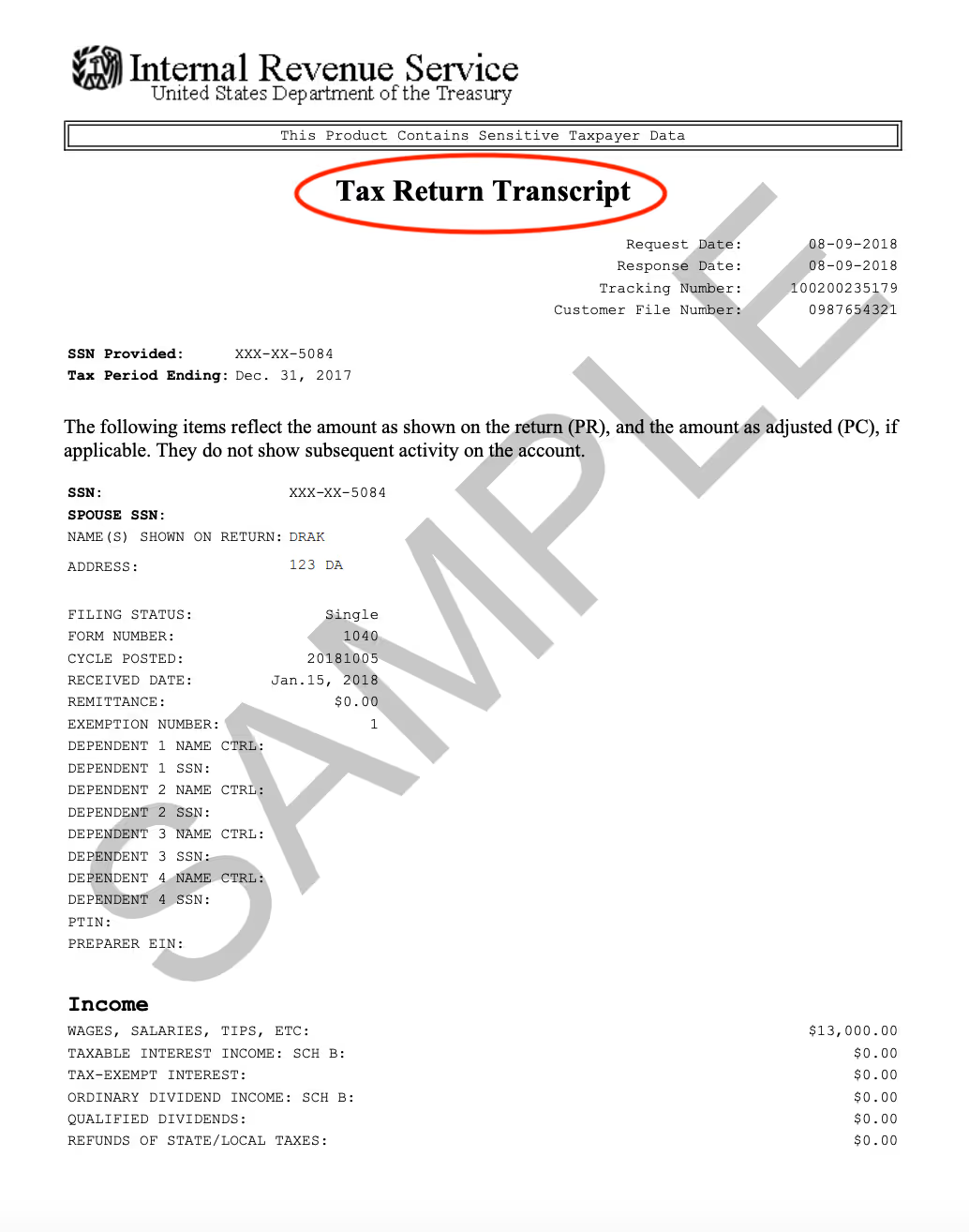
Federal Tax Returns:
Form 1040: The form 1040 is generally 2 pages long, and looks like this:
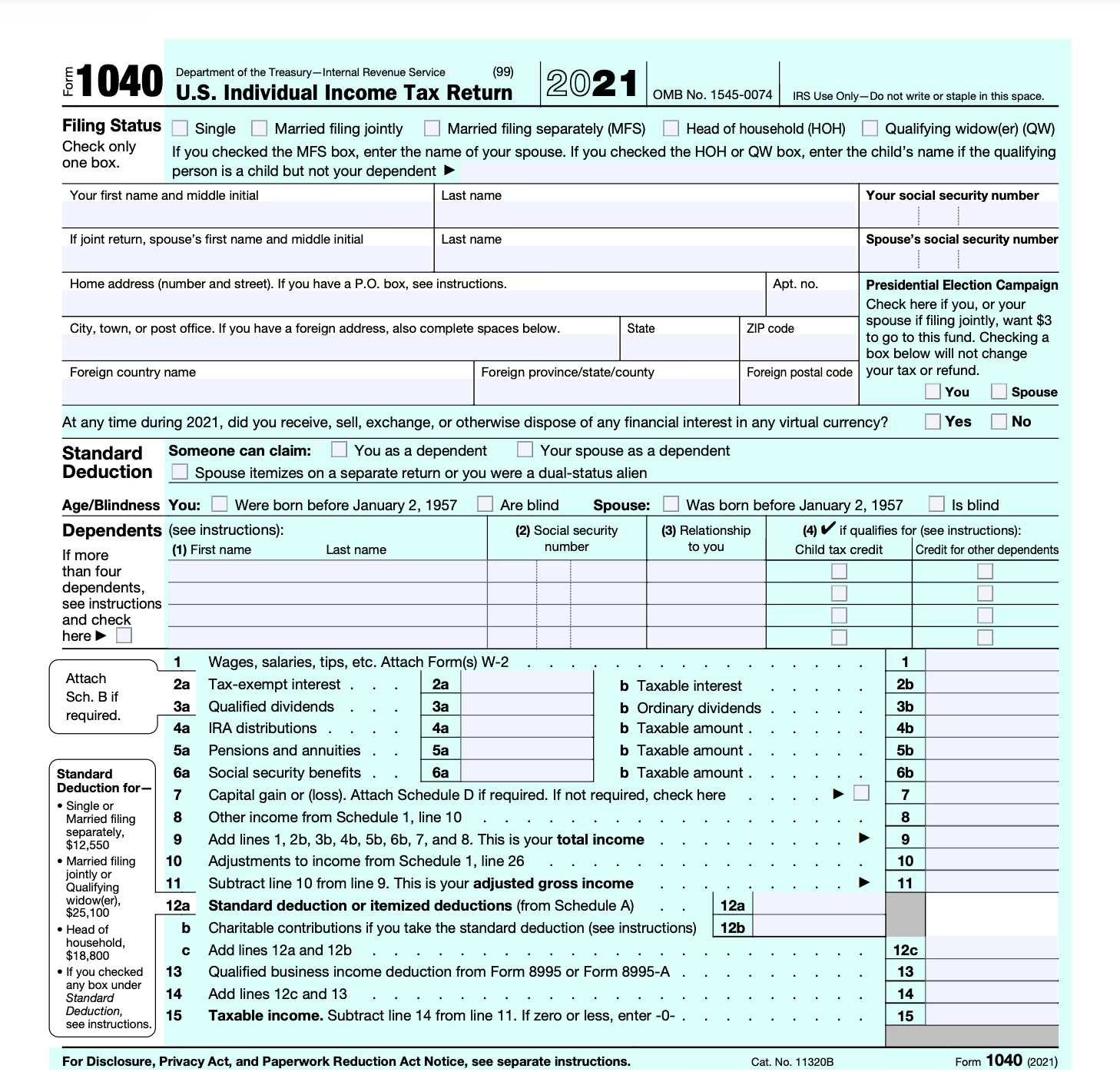
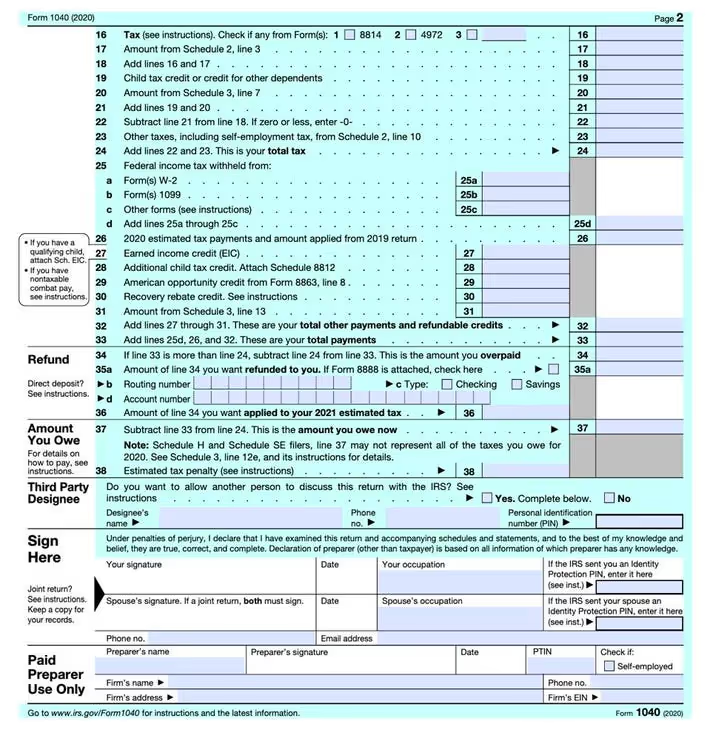
Federal Schedules - Federal Schedules have titles like “Schedule 2,” “Schedule D,” “Schedule SE,” “Form 8995” etc. They are usually located directly after the Form 1040 in the tax return. State taxes, and any pages titled “worksheet” should not be included.



If you have any questions about your tax documents as you prepare your application, please don’t hesitate to reach out to our live chat! If you would like more specialized support, all of our green card application packages come with a full attorney review. During the review, the attorney will double-check all of your documents, and let you know if anything is missing. You can sign up for one of our application packages here.
Understanding the K-1 Letters of Intent to Marry
Applying for a K-I Visa can be stressful, but we are here to help.
General Immigration Information
What is a Letter of Intent to Marry?
A Letter of Intent (LOI) to Marry is one of the documents USCIS requires as part of the K-1 visa application. It is a letter that helps USCIS verify the relationship. In a Letter of Intent to Marry, the petitioner (the U.S. citizen) and the beneficiary (the applicant/intending immigrant) declare their intention and legal ability to marry within 90 days of the applicant’s arrival into the United States.
Attention! USCIS requires that both the petitioner and the beneficiary each write and sign their own LOI to Marry, which means that two letters of intent should be submitted in total.
What should be included in a Letter of Intent to Marry?
Depending on the specifics of the couple's situation, a Letter of Intent to Marry may include the following:
- A statement of the intent and legal ability to marry
- Both the petitioner and the beneficiary’s names
- A signature and date at the bottom of the letter
- Supporting evidence of wedding plans
What does a Letter of Intent to Marry look like?
The formatting of a Letter of Intent to Marry can vary, but a basic template can be used to ensure all necessary information is included.
Below are templates as well as examples of what a basic LOI to Marry can look like. Please remember that the petitioner and the beneficiary should each write their own letter, and that letters should be unique in content and writing style, even though both letters can follow the format shown below.
Templates & Examples
Template - Petitioner
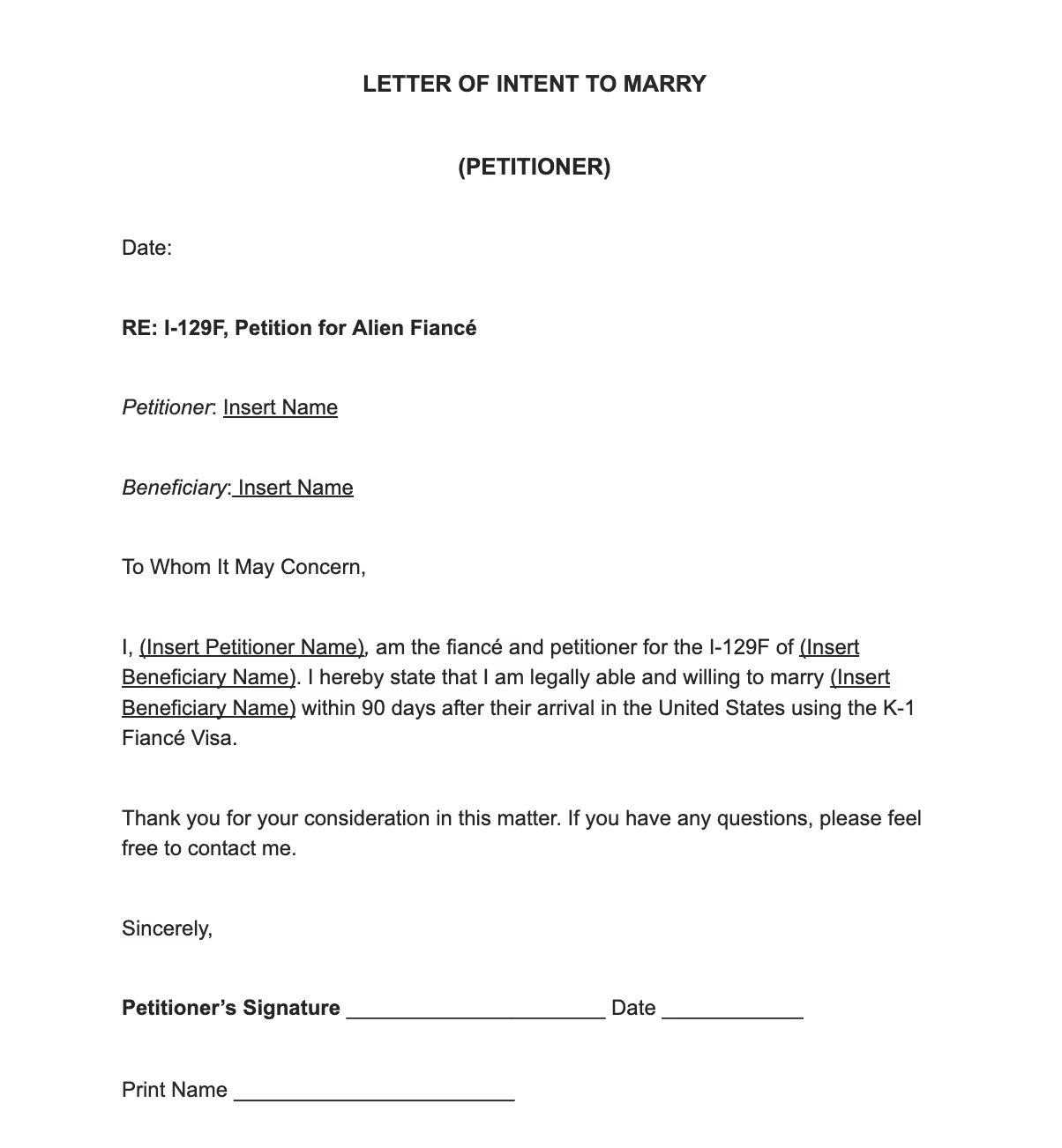
Example- Petitioner
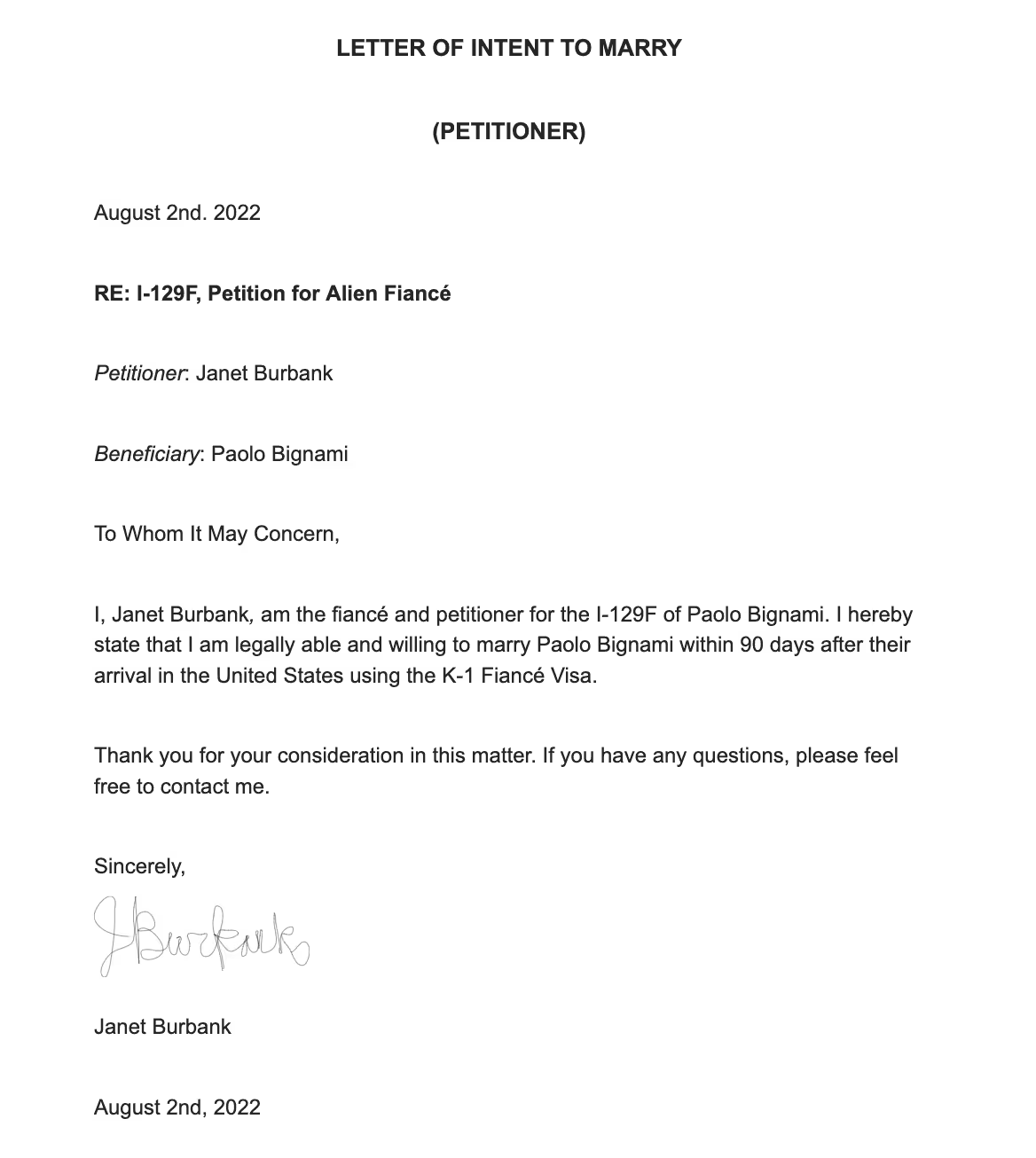
Template- Beneficiary
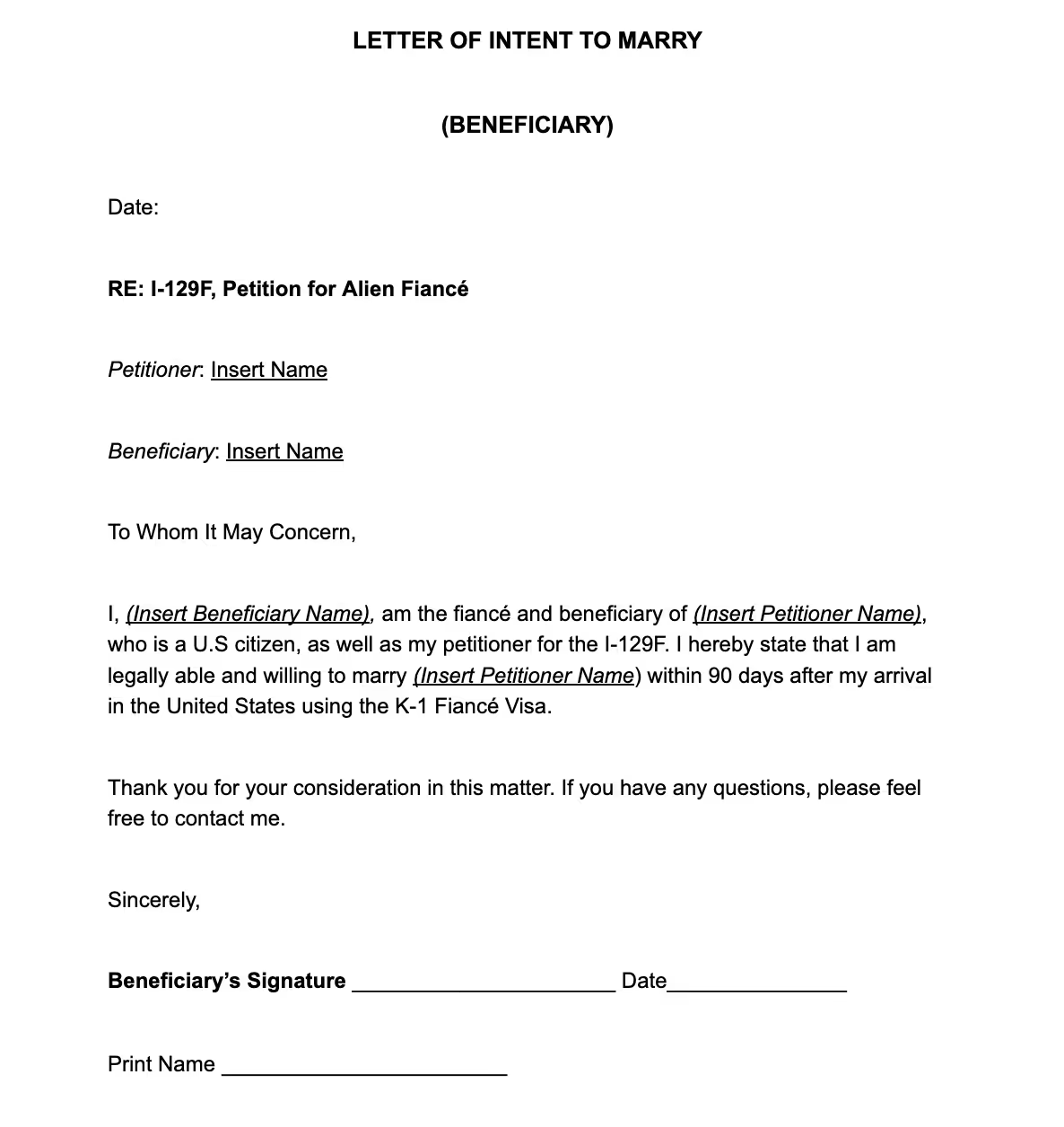
Example- Beneficiary
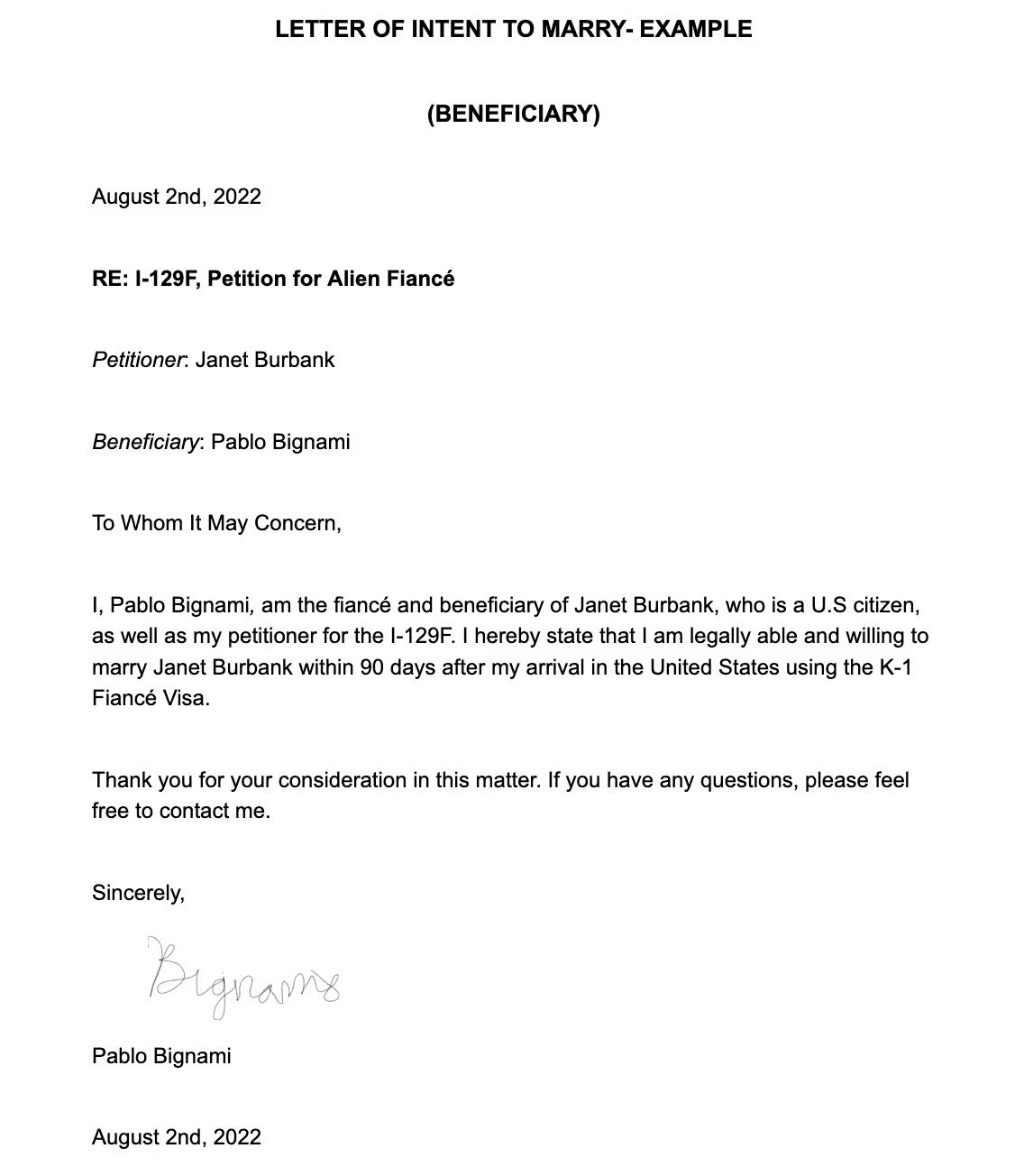
FAQs
Who needs to write a Letter of Intent to Marry?
The petitioner and beneficiary are each required to write their own Letter of Intent to Marry.
Is evidence required? What can I use as evidence?
Including supporting evidence with the K-1 visa application is required. However, USCIS does not have specific requirements for what must be included.
Evidence can include:
- reservation receipts for venue or catering,
- engagement photos,
- ring receipts,
- engagement announcements,
- text messages showing proof of wedding plans,
- communication with friends and family about the wedding,
- social media posts.
What if I don't know when the marriage will take place since it is dependent on the visa approval?
In cases where the marriage is dependent on visa approval, include as much information as possible about plans to marry. Although a specific date may not be set yet, general proof of the wedding taking place can be added.
This can include information about the couple’s relationship, timeline, and story, as well as proof of conversations about the couple’s upcoming marriage and that friends and family were made aware. Including evidence can be a good way of supporting the validity of the relationship.
Need help applying for a K-1 visa?
Applying for a K-I Visa can be stressful, but we are here to help. With packages including online support and reviews with our independent licensed partner immigration attorneys , all with a 100% money back guarantee, we have you covered. Click here to learn about our K-I visa packages.
We’re happy you’re here!
Understanding USCIS’ Race and Ethnicity Questions
Explore the definitions of race and ethnicity, how USCIS defines them, and how customers use them.
General Immigration Information
On many applications USCIS requires people to declare both their race and their ethnicity. In this article, we are going to explore the definitions of race and ethnicity, how USCIS defines them, and examples of how some people have chosen to interpret and respond to these questions in the past.
What is the difference between race and ethnicity?
Race is a concept that usually refers to the phenotypical (physical) characteristics of a person and it can be self-identified or not. On the other hand, ethnicity takes into account the cultural components of a person’s upbringing, and it doesn’t typically refer to physical characteristics of that person. For example: Two people that both identify as Hispanic as their ethnicity may choose differently for their race, one White, another Black, or a mix of both.
How does USCIS define the different options?
On their applications USCIS usually has 2 questions about Race and Ethnicity:
- The first one that asks for a person’s ethnicity: The question simply asks if you consider yourself Hispanic or Latino OR Not Hispanic or Latino
- The second one asks for a person’s race and you can answer by marking one or more boxes. The options are: White, Asian, Black or African American, American Indian or Alaska Native, Native Hawaiian or Other Pacific Islander.
Here is the definition of the different race options directly from USCIS instructions:
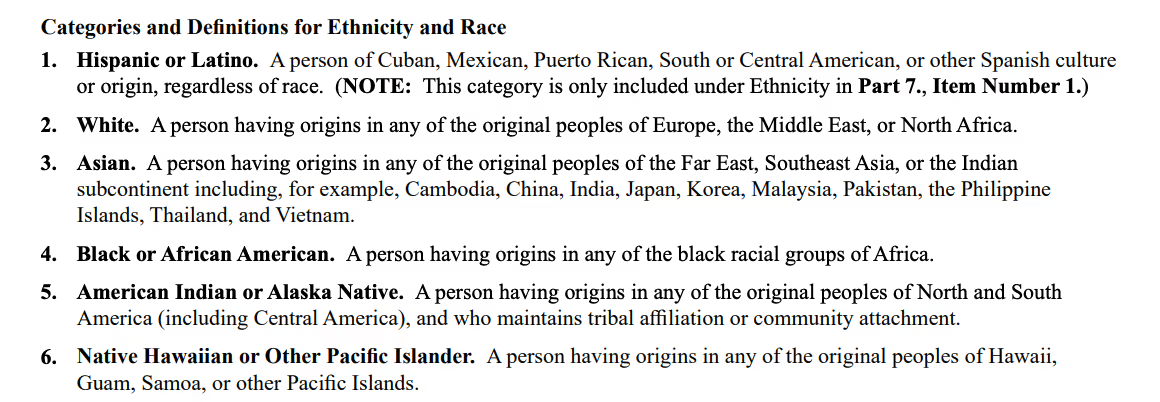
"When choosing between the race options, please make sure to carefully read through the USCIS definition of each of the options first.”
How should I answer if I am Hispanic/Latina/e/o/x?
Because USCIS considers Hispanic or Latino to be an ethnicity instead of a race, many people that choose the option “Hispanic or Latino” have different responses in the race question. Due to the multi-racial category that is Hispanic/Latina/e/o/x, many people choose between the options of White, Black, American Indian (if they have maintained tribal affiliation or community attachment as USCIS instructions show) or choose to mark more than one box.
How should I answer if I identify with more than one race/I Identify as biracial or multiracial?
The race question asks to mark *all applicable boxes*, so if you are a multi-racial person you can choose to mark all the boxes that apply to you.
Conclusion:
Please take into account that there isn’t a wrong or right answer for these questions. However, understanding USCIS definitions for race and ethnicity as well as a more clear understanding of how they define the various options within those questions, will hopefully help you answer this question more confidently and accurately.
Employment Verification Letter (EVL) 
Learn what an Employment Verification Letter is, why it's important and what it should include
General Immigration Information
What is the purpose of an employment verification letter?
When going through the immigration process, it is crucial to prove that the sponsor, and when applicable, the joint sponsor, meet the necessary financial requirements for their household size. In addition, USCIS will want to see proof of their current employment status. Both of these things are accomplished, in part, through an employment verification letter (EVL) that is submitted as evidence along with Form I-864. The employment verification letter provides evidence of both current employment and income.
Please note that an employment verification letter is different from an offer letter. An offer letter proves that employment was offered and an employment verification letter proves that employment is ongoing.
The employment verification letter is needed in addition to tax returns, pay stubs, and other financial documents. It is meant to strengthen the case by supporting the sponsor’s claim that they are able to provide adequate financial support to the applicant.
Who needs an employment verification letter?
The sponsor and, when applicable, any joint sponsor on a green card application will need to provide an employment verification letter. If the applicant is using their qualifying income to help meet the income requirements, they too will need to include an employment verification letter. The letter(s) will be required as evidence for Form I-864.
Creating an employment verification letter:
Who should issue an employment verification letter?
The employment verification letter should be issued by the company's HR department or the direct supervisor of the sponsor.
What type of paper should the letter be on?
The letter should be on official company letterhead.
What information should be included?
- The date that the employer is writing the letter. This should be within 2-3 months of submitting the application, ideally.
- The name, company address, and title of the person writing the letter.
- The employee’s position at the company.
- The date the employee started at the company.
- A description of the employee’s responsibilities.
- The annual salary (preferred) OR weekly rate and average weekly hours of the employee.
- The employee’s current status (part time/full time OR average hours worked per week).
- Wherever possible, a statement of prospective future employment (ie. a statement saying that the company anticipates you working there for an extended amount of time).
- Signature of the writer (HR representative or direct supervisor).
Example of an employment verification letter:
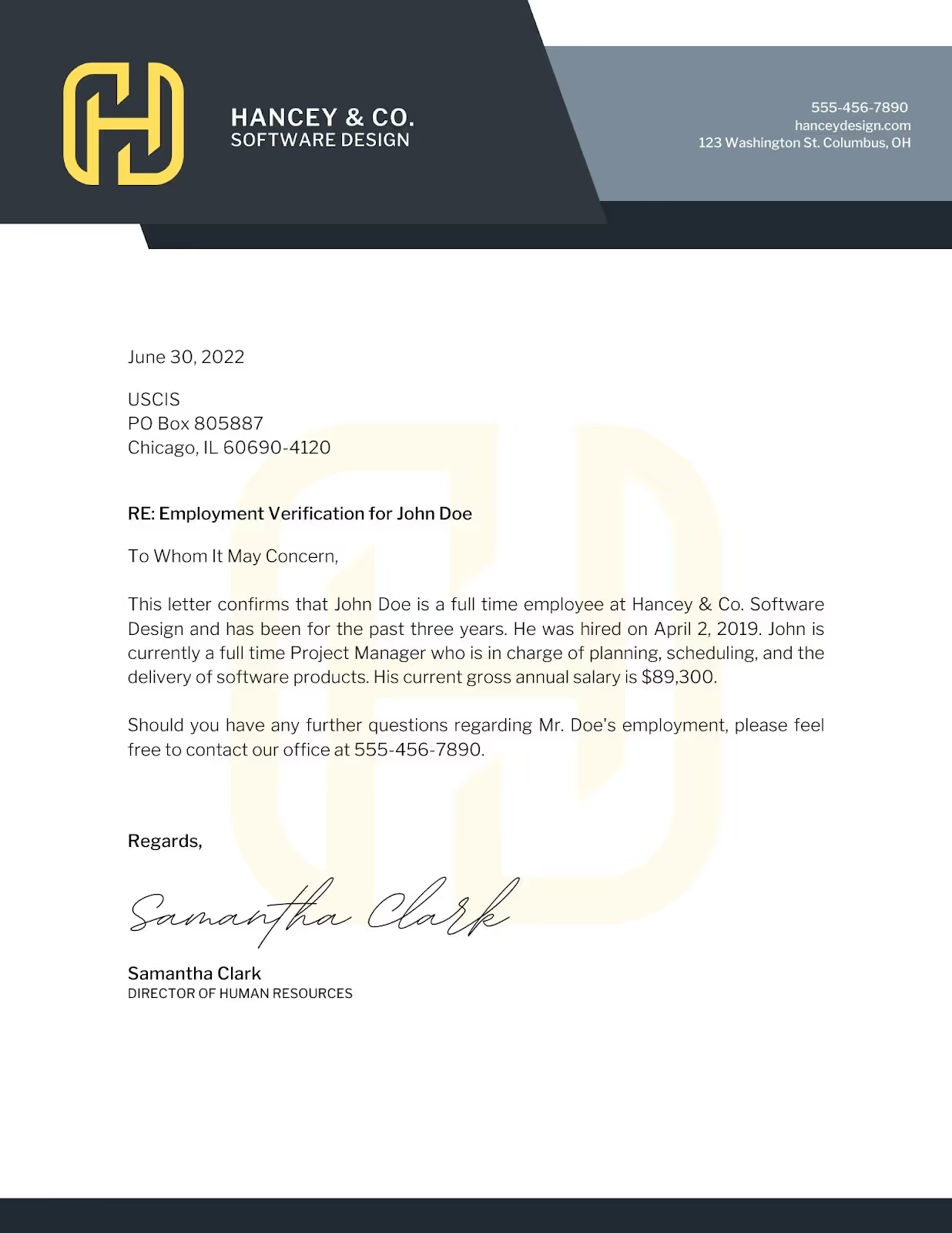
Employment verification letter template:
If you need some help getting started, click here to download a copy of our employment verification letter template.
FAQs:
What if I am self-employed?
When going through the Simple Citizen process, the system will let you select that you are self-employed. It will then ask you a series of questions about your income, job description, and dates of self-employment. The answers to these questions will replace the need for an employment verification letter with a list of new required documents.
What if I have more than one job?
If you have more than one job, you will need to include an employment verification letter for each job that you are currently employed at. You will then add the combined income values on all forms as the total annual income in the questionnaire.
I just started my job – do I still need an employment verification letter?
If you just started your job, adding the original offer letter as well as an employment verification would be the best way to illustrate your current employment to USCIS. USCIS is less likely to accept a sponsor’s documentation as sufficient if they started the job recently. Adding an Employment Verification letter with a statement of prospect of future employment (ie. a statement saying that the company anticipates you working there for an extended amount of time) can help improve your odds.
I have an employment verification letter from 5 months ago. Can I just submit with that one?
Since the overall goal of the employment verification letter is to prove that you are currently employed, you want to make sure the letter is as current as possible. As a best practice, your letter should be dated no more than 2-3 months before your application submission date.
What if I am paid hourly?
If you are paid hourly, you will want to have the author of the letter add your hourly rate and average hours worked each week. If your employer does not include an estimate of your annual income in the letter, best practice would be to also upload a signed conversion letter showing the math used to calculate your annual income.
How to calculate annual income:
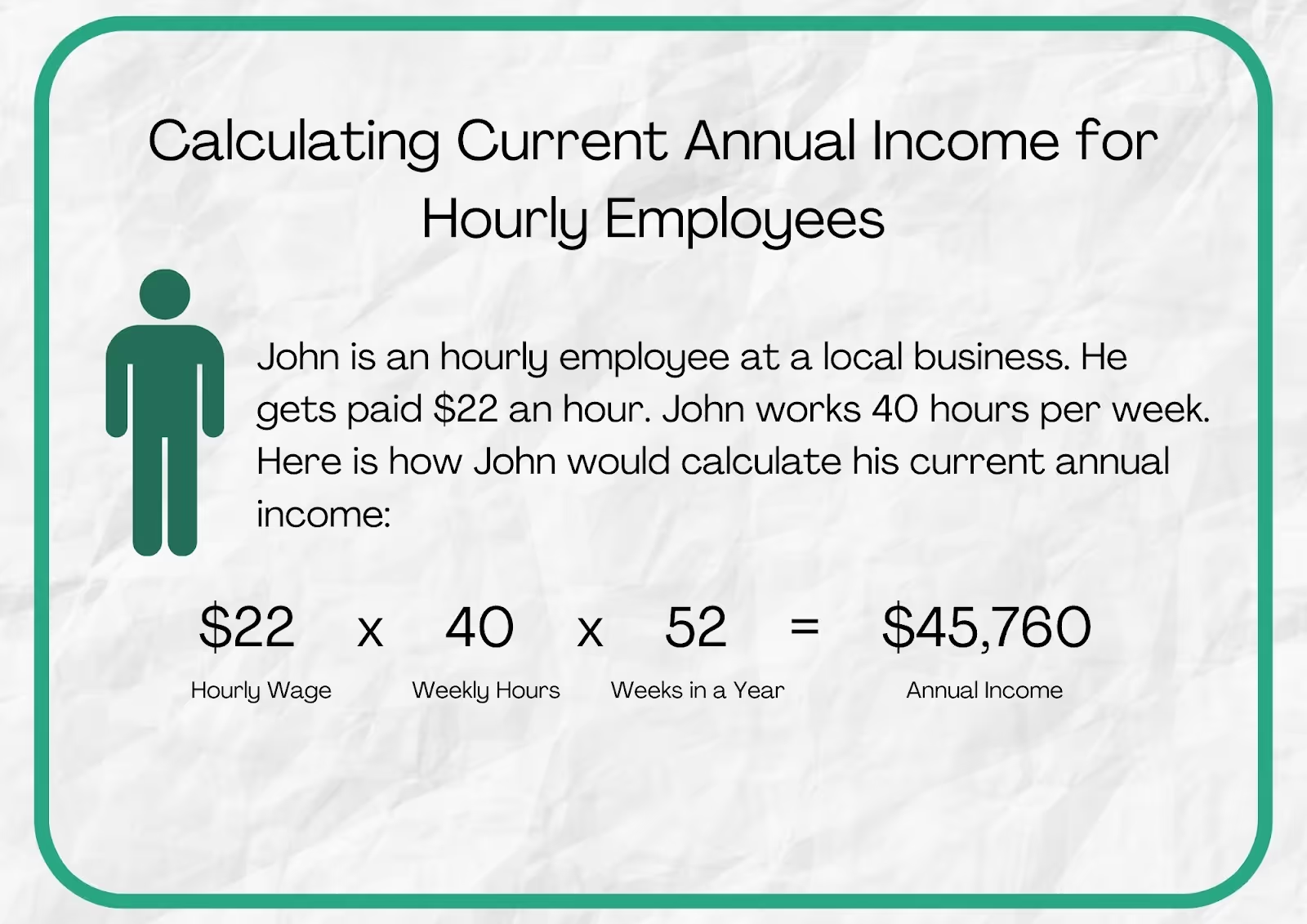
Conversion Letter Outline:
“Date
Dear USCIS officer, as shown on the employment verification letter, my hourly pay is _X_ dollars an hour and I work an average of _X_ hours each week.
[hourly pay] x [avg weekly hours] x [52 weeks/year] = a calculated estimated annual salary of _X_.
Name
Signature”
Conversion Letter Sample:
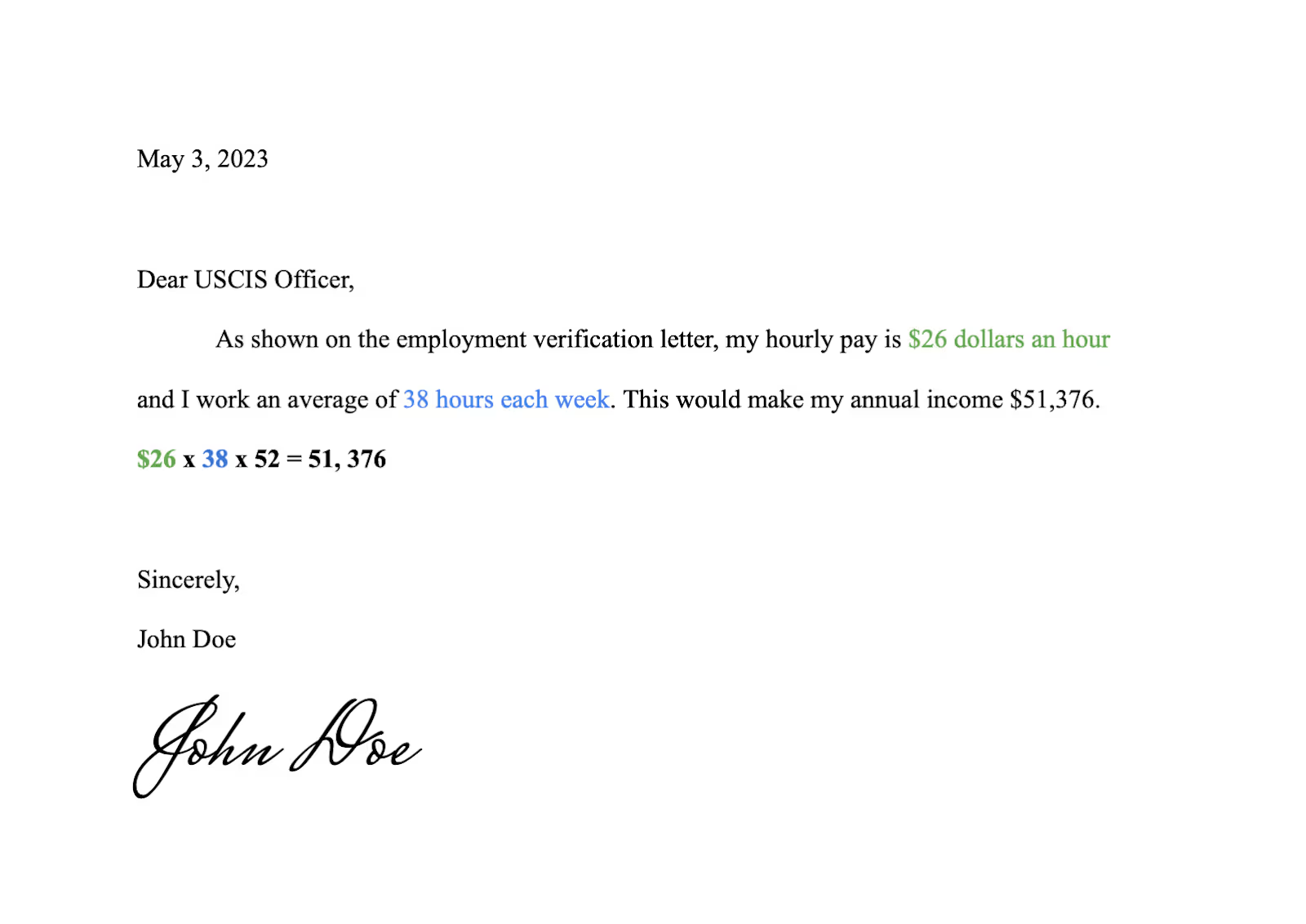
Relationship Evidence for the Marriage-Based Green Card Application
Tips and tricks for submitting marriage-based relationship evidence with your green card application.
Green Card Application
For most individuals hoping to file for a green card through marriage, USCIS requires evidence that the petitioner and applicant are in a bona fide marriage. In other words, USCIS asks for applicants to provide a variety of documents showing that their relationship is well-established and that it was done in good faith. This article provides the following:
- The basic guidelines for Relationship Evidence documents
- Some of the warning signs that might cause USCIS officers to be more picky about approving an application
- Lists of ideas for different types of evidence that may be included
- Tips for compiling evidence
Basic Guidelines
The following are basic guidelines for all relationship evidence:
- USCIS expects a variety of evidence to prove the legitimacy of the relationship. Generally this can be done by providing around 100-200 pieces of relationship evidence, including 15+ different types of evidence.
- All evidence must be in English, otherwise, a certified english translation must be provided. You can find out more about providing certified self-translations here.
- Non-photo evidence must include the names of both individuals in order to be considered by USCIS as evidence
Please note that variety is generally more effective than quantity, so an application with 150 pages of photos would likely be considered weaker than an application with 90 pages that included 16 different types of evidence.
Warning Signs
The following circumstances may cause your application to receive greater scrutiny from USCIS:
- Large age disparity
- Inability of petitioner and beneficiary to speak each other’s language
- Vast difference in cultural and ethnic background
- Family or friends unaware of the marriage
- Marriage arranged by a third party
- Marriage contracted immediately following the beneficiary’s apprehension or receipt of notification to depart the United States
- Discrepancies in statements on questions for which a husband and wife should have common knowledge
- The couple is not currently living together, even if there are valid reasons.
- Beneficiary is a friend of the family
- Petitioner filed previous petitions on behalf of other intending immigrants, especially immigrant spouses
- No proof of shared finances or joint financial responsibility
For couples in any of the above circumstances, a large quantity of evidence can give USCIS a better insight into the relationship to prove it is real and was not entered into for immigration benefits.
Suggestions for Different Types of Evidence
The lists below provide ideas for different types of evidence you might include in your application. They are divided into different categories for convenience. Please note that USCIS recognizes that each couple’s circumstances are different, so not everyone will have the same evidence. You are welcome to get creative and add things to your application that are not on this list.
Additionally, none of the items below are technically required. Rather, they are just suggestions to help get you started. That being said, there are certain types of evidence that may raise red flags if not included. In particular, please try to include photos of the couple together, proof of shared address, proof of spending time together, and proof of shared finances.
1. Evidence of spending time together
When gathering proof of spending time together, it is helpful to focus on evidence that shows the length of the relationship, and also that shows that the relationship is public, and that friends and family are aware and involved in the couple’s lives. Here are some examples:
- Travel itineraries and lodging bookings from joint vacations or get-aways
- Photos from joint vacations or trips, especially trips abroad to visit relatives
- Cards from loved ones complimenting you on your wedding, anniversary, or other joint life events
- Evidence that the spouses have met or communicated with each other's parents and relatives, including photographs, letters, cards, emails, messages, etc.
- Telephone and instant message records demonstrating that the spouses communicate regularly
- Photographs from the couple’s wedding, honeymoon, get-aways, family meals, holidays, etc. List the date and names of the people in the photographs
- Tickets to events both spouses attended or plan to attend
- Receipts for gifts spouses bought for each other
- Records of social media posts and interactions, including screenshots of Facebook pages, Twitter posts, Instagram posts, etc.
- Documents showing membership in the same clubs, churches, teams, etc.
- Documents showing that one spouse took the other’s last name
- Proof that a spouse went to visit the other spouse’s family outside of the United States, that is a great indicator of a marriage “in good faith”
2. Evidence of sharing finances
Many married couples combine finances or split expenses in some way. Although it is becoming more common to keep finances more separate, USCIS uses this as a large part of their decision on if a relationship is legitimate. Commingling some finances can help show evidence of a good faith marriage. Use these documents to show evidence of shared finances:
- Bank statements for joint accounts showing both names
- Statements for loans where one spouse is a co-signer for the other spouse
- Voided and canceled checks for joint accounts
- Joint insurance agreements, statements, and cards, including health, life, property, and auto insurance, etc showing both names
- Utility bills showing both names, including, cell phone, trash, cable, internet, electricity, water, gas bills, etc.
- Life insurance policies, wills, and trusts, showing a spouse as a beneficiary
- Documents showing joint ownership of cars, real property, or investments
- All tax returns filed jointly as a married couple showing both names
- Funeral plans or intended burial locations that involve or are close to a spouse
- Copies of bank statements from separate accounts and payment receipts showing that the spouses both contribute to financial responsibilities and payments. For example, bank statements from separate accounts could show that each spouse pays half of rent each month - please be sure to highlight the important transactions, and maybe include an explanation note
- Copies of vehicle titles showing joint ownership
- Venmo, CashApp, or wire transfers between the couple
While commingling finances isn’t technically necessary, USCIS tends to see it as strong evidence that the marriage is legitimate. Applications that do not include proof of shared finances tend to be treated with higher scrutiny.
3. Evidence of living together
Because most married couples live together USCIS sees this as another strong form of relationship evidence. Showing evidence of cohabitation, or living together is a good place to start. Use these documents to show evidence of cohabitation:
- Mortgage or loan papers with both names
- Any and all Lease agreements showing both names
- Bank statements giving the same address for both spouses
- Driver’s licenses or identification documents showing the same address
- Voided or canceled checks showing the same address
- Deed to property indicating both names
- Property insurance agreements, statements, or cards showing the same address
- Health and life insurance statements showing the same address
- Correspondence from friends, family, or businesses showing the same address
- Utility bills showing the same address, including, cell phone, trash, cable, internet, electricity, water, gas bills, etc.
- Affidavits from family, friends, neighbors, and landlords testifying of cohabitation (more on this later)
Cohabitation isn’t necessary for a marriage to be legitimate, but if a couple is not living together, their application is likely to receive greater scrutiny. If a couple is not living together, it may be helpful to include a letter explaining why they are not living together, along with any plans that they have to move in together in the future.
4. Evidence of raising children together
Showing proof of raising children together is fantastic evidence of a legitimate marriage. If a couple shares children, they can consider using these documents as evidence:
- Adoption certificates showing the two spouses as the parents
- Birth certificates showing both spouses as parents
- Documents that show a relationship with children or step-children, including vacation itineraries, photos, school records, affidavits from friends, family, and teachers
- Documents showing the step-parent as the emergency contact for a step-child, including, doctor’s records, school records, etc.
- Medical records showing an ongoing pregnancy
- Photos of the couple with the shared child
- Evidence of pregnancy - Ultrasound photos, baby announcements, shower invites, etc.
In addition, raising step- or adopted children together can also be very convincing evidence for USCIS, but it is by no means mandatory.
Affidavits
Affidavits of support from family and friends can also make great relationship evidence. These are letters that show support for the marriage. This article gives an in-depth explanation of what these letters should include, and includes several sample letters.
Tips for Assembling Your Relationship Evidence
Here are some tips and tricks that can help with assembling relationship evidence. These tips are not required, but they can make it easier to assemble the evidence, and for the USCIS officer to process your application!
- Show Both Names: As much as possible, please make sure that both couple’s names are on all non-photo documents, especially leases, bank statements, travel itineraries, etc. USCIS has to clearly see that both people are connected to each piece of evidence.
- Add Captions to Photos: Adding captions to photos and other documents is not required. It can be helpful, however, especially to help explain evidence that is less clear (such as a flight itinerary with only one person’s name on it because they were traveling to visit the other person).
- Combine Files Before Upload: Applicants are welcome to just upload individual photos and documents to our website if they would like. However, once documents are uploaded, there is limited ability to edit and rearrange them. If you would prefer more control over how your relationship evidence will appear in the final application, you can put all of your photos and documents into a word document or powerpoint, save it as a PDF, and upload that.
- Upload Files as PDFs: Whenever possible, please be sure to upload documents as PDFs, not as JPEGs. This is especially true for any word-heavy documents (such as letters of support, screenshots of emails, bank statements, etc.) Uploading them as JPEGs will decrease the image quality and make it very difficult to read the information.
Providing a wide variety of relationship evidence is a great way to strengthen your application and reduce the risk of receiving a Request for Evidence. If you have any questions about gathering relationship evidence, please don’t hesitate to reach out to our live chat. If you would like more in-depth and specific feedback from an attorney on your application, all of our marriage-based green card packages include a full attorney review. You can sign up for one of our application packages here, and we will be happy to help guide you through your application!
Alert: USCIS Issues Recommendation for I-485 Applicants to File Form I-693, Report of Medical Examination and Vaccination Record, with Initial I-485 Filing to Potentially Speed Up Processing Time
Adjustment of status applicants must now submit the medical exam at the time of I-485 submission.
U.S. Immigration News
Dated: December 5, 2024
Dec 2, 2024 Update: While USCIS previously allowed Form I-485 to be submitted without a complete Form I-693, Report of Immigration Medical Examination and Vaccination Record, they changed that rule as of December 2, 2024, and now require that adjustment of status applicants submit the medical exam at the time of submission of Form I-485.
On December 14th, 2022 USCIS informed the American Immigration Lawyers Association (AILA) of their recommendation that green card applicants filing form I-485 file, Application to Register Permanent Residence or Adjust Status, also file Form I-693, Report of Medical Examination and Vaccination Record, along with their application.
While applicants do have the option to file the I-693 either with the initial application or at a later point as requested by USCIS, this new recommendation to file it with the initial application is given due to USCIS’s expansion of potential interview waivers for family-based application. By including the completed medical examination with the I-485 filing, applicants will reduce the risk of receiving a Request for Evidence for the I-693 if USCIS chooses to waive their interview.
USCIS has not provided the methods that they use in determining whether a case’s interview will be waived.
Information retrieved from AILA Doc No. 22121452

